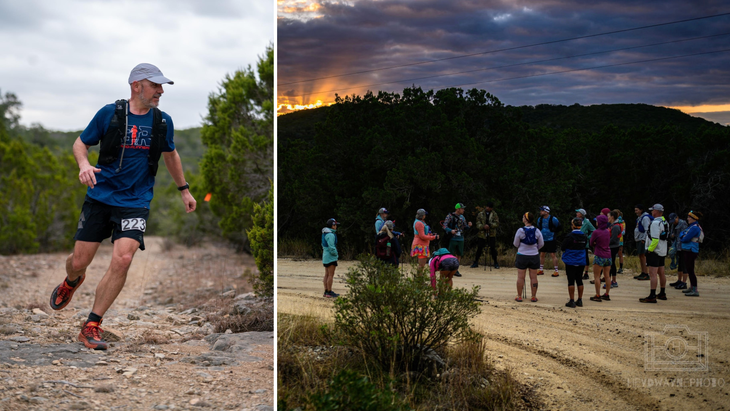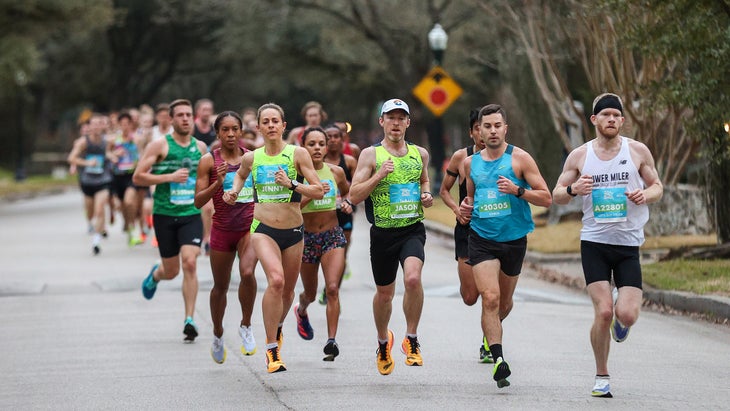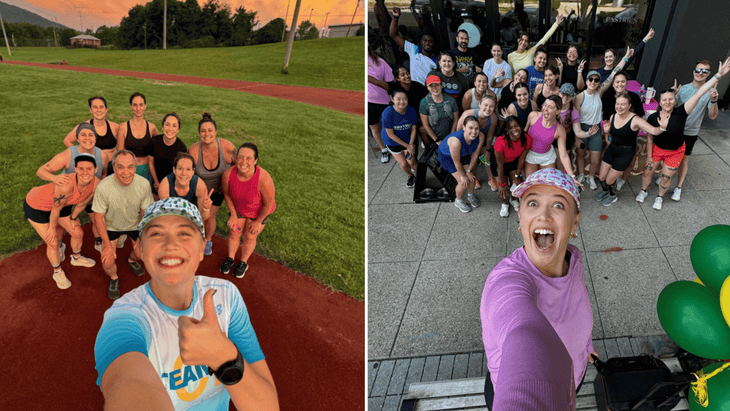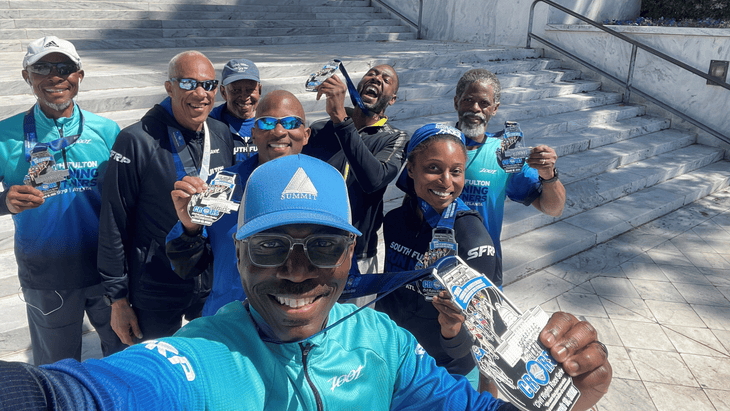New perk: Easily find new routes and hidden gems, upcoming running events, and more near you. Your weekly Local Running Newsletter has everything you need to lace up! Subscribe today.
Content Warning: This article discusses sensitive topics related to mental health and suicide. If you are in crisis, please call, text or chat with the Suicide and Crisis Lifeline at 988, or contact the Crisis Text Line by texting TALK to 741741. Remember, you are not alone, and help is available.
It was just as a Sunday is supposed to be: relaxing, sunny, the perfect day for Ryan Yedlinsky to spend out back with his kids. He remembers enjoying that right before he went down to the basement with the intention to never come back up.
The day spiraled so quickly, as it can for veterans with post-traumatic stress disorder, with seemingly nothing to trigger the overwhelming desire to end his life. He knows now what happened. Hindsight provides a good road map.
“I was in therapy, digging up old memories,” Yedlinsky, 49, said. “I’d been in it for a long time. We’d been talking lately about how much I love my kids, and I realized at that moment that I couldn’t protect them.”
Yedlinsky served in the military for 17 years, including in Afghanistan. He speaks about the day in July, 2023, like it was just a bump in his recovery. His story resembles that of a lot of other veterans even years after they return from war. He also understands it could have been much worse. The thing is, he found help.
He is a member—president, actually—of Band of Runners, an organization that introduces trail running to veterans like himself. It was created to help veterans such as Yedlinsky reconnect with nature as a safe and healthy place.
Running, like many things, is not a cure-all for PTSD. Yedlinksky was still on active duty when he found running. It happened one night when he was off duty and watched the livestream of the Leadville 100, which his brother-in-law was racing. Now Yedlinksky’s done five 100-milers and still runs ultras.
But even if Band of Runners didn’t necessarily help Yedlinksky discover trail running, it did give him hope. It provided community.
Yedlinsky may not have much in common with you. You may be a road runner, and you may not be a veteran. But many runners thank (or blame) their community for inspiring them to do things they never thought possible, such as winning their age group in a local 5K, running a marathon, or just running at all.
Running is inherently individualistic—no one can log the miles for you. And yet, communities are as important, and perhaps more important, in running than any other sport or recreational activity.

The Power of the Pack
What happens when your alarm goes off at 6 a.m. on a Saturday morning? If you jump out of bed into your running clothes and down a breakfast of bran flakes and Tailwind, well, good for you. As for the rest of us, we fight demons, right? The ones who whisper that the bed feels so nice, and it’s too chilly to run, and we’ll probably finish that marathon even if we run, say, a baker’s dozen instead of 18.
One of the big benefits of finding a community is it helps us fight those demons off, even when everyone else in said community is probably fighting them, too. Three-time Olympian Jenny Simpson has noticed this trend during her year-long running tour of the U.S.
“People will show up for each other in a way that’s hard to show up for themselves,” Simpson said. “The weather is terrible, and it’s early in the morning, but the group is getting together so of course you will be there.”
Yedlinksky lives in Kansas City, Kansas, and attended a Band of Runners event after a friend recommended it to him. He fell in love with running on the local trails—especially with those who had shared similar experiences. He’s Midwest Nice, and doesn’t look like a guy who would get angry at anything except how the Kansas City Chiefs performed at the 2025 Super Bowl. But PTSD has its triggers. He still, for instance, can’t sit in a restaurant without a clear view of the exits.
“When I’m out on the trails, I don’t feel any of that,” Yedlinsky said. “I don’t feel nervous. I don’t feel angry. There are very few problems that you can’t solve by a six-hour run in the woods.”
Yedlinsky also volunteers as a mentor with Band of Runners and spends a week or more with coaches and other veterans with varying degrees of experience running on trails. Some of them have never touched dirt on a run. The point isn’t to train them for Leadville; the point is to give these vets the chance to experience the meditative effect of nature and trail running with others who know exactly what they’re going through.
“It really makes me feel great to see a veteran who is clearly having issues and within a few days, you see a change,” he said. “You really do.”
Brick-and-Mortar Built

The generative momentum of running with others is why many specialty running stores curate community: People tend to reach their goals easier when they run with others, and if they meet those goals, they’re likely to stay runners (and, yes, buy more shoes).
“It makes it easier, especially on a longer distance or if you’re just starting out,” said Dave Martinez, the owner of Big Peach, a running store with several locations in Georgia. “It makes the miles disappear, and it keeps you accountable. If you’re running by yourself, it’s a lot easier to quit if you’re tired.”
Simpson trained with world-class resources en route to winning a gold medal in 1500 meters at the 2011 world championships and earning bronze at the 2016 Olympics. But she attributes a good portion of her decorated career to her first pair of shoes, which she got at TrackShack, the local running store in downtown Orlando, Florida.
She was still in elementary school, or close enough, when she wandered into the store. She didn’t come from a family of athletes, but she really enjoyed running and wanted to get some shoes. She remembers the store owners, Jon Hughes and Betsy. They were two employees who met at the store, eventually married, and bought the business. They introduced her to their community of runners. She ran with them and they told her, “Hey, kid, you’re pretty fast.” She listened. It changed her life.
This is an extreme example, of course. Most people who wander into a running store don’t become Olympians. But once they get involved with their running community, they might become marathoners.
“My story is Cinderella,” Simpson said. “I feel so lucky that I found my people so early in life. But that kind of story is in hundreds of thousands of iterations across the country. Elite track and field had my focus and my heart, but it’s really the grassroots scene that got me into running.”
Indeed, many running communities are birthed in specialty shoe stores, so much so that they’re the first places Jenny and her husband, Jason, visit when they make it to a new state on their year-long running tour of the U.S. The two are traveling across the country in a van and meeting runners along the way. They don’t have a sponsor for their tour, and the point isn’t to make money: Following Simpon’s retirement from professional running last year, they just want to explore communities that make runners do really hard things for fun.
“If you have a pair of running shoes,” Simpson said, “you can find your people and have a little bit of an adventure.”
They highlight run stores because that’s the easiest way to find a ready-made running community, both said, and they want to promote them to keep that part of running alive. Through the stores, they’ve run with teachers at 4 a.m., huddled around fires in barrels in Alaska, and talked about pooping with strangers, because oversharing about bathroom horror stories is a rite of passage among runners. Simpson calls this last part “sweet, honestly.”
“It’s an inside joke between you and your running friends,” Simpson said.
Overcoming Cliquishness
The glaring caveat to communities is they can feel cliquish. It can be tricky, even downright difficult, to make beginners feel included in a group of longtime runners who run at the same pace. Generally this pace isn’t what beginners would call a “fun run.”
“That has always been the challenge,” Martinez said. “Not everyone sees themselves as runners when they’re starting out. Even going in to get shoes, they can feel judged. So if someone goes to a run club and gets left behind, you’ll never see that person again.”
It’s the worst feeling, Martinez said, to be left behind and not know where to go. He believes runners, for the most part, do generally remember what it was like to start out and will try to be supportive, He starts group runs in the back of the pack. “I just want to make sure everyone is safe and included,” he said.

Mackenzie Rink, who goes by The Realistic Runner on TikTok, posted about this experience a couple times. She said getting left made her feel “less than” and, indeed, she hasn’t returned. She labels herself as a “slow” runner and advocates for paces that match, such as 12-minute miles or higher. She’s even hosted run meetups at races with one promise: No one gets left behind.
“You have to acknowledge that it’s an awkward experience,” Rink said. “I hate running with people sometimes. You’re sweating and breathing hard. It’s not cute. But it’s important that people know that they can be their most authentic self.
Feelings of uncertainty infect all runners at first, even those who turned out to be some of the best in the world. Liza Howard was curious about trail running but hesitated for a year before finally joining a group of older guys.
“I didn’t think I was fast enough or good enough,” Howard said.
It’s funny to think about it now, given that Howard won the Leadville 100 a couple times and finished second a couple other times. Her experience is what led her to coach and help lead Band of Runners, the group that helped Yedlinsky and many other veterans find their place.
“You just need that one person to say you’ll be fine,” Howard said.
It’s Not Just About Running

Torian R. Priestly feels like he’s part of a group when he runs with South Fulton Running Partners. He didn’t always.
“When I ran in the ’80s, it was a lonely thing,” Priestly, an executive for a real estate development group, said. “But I loved running, so I didn’t look at it as being the only Black guy in a race.”
The running club was founded near Atlanta in 1979, making it the self-proclaimed oldest Black running club in the U.S. That distinction is meaningful to Priestly.
“When the club was founded, you didn’t have Black people running long distances,” Priestly said. “But it exposed something to our community that we didn’t have.”
The club promotes community as much as it does running, and its members are expected to volunteer as well as show up on Saturdays, when they socialize and eat good food after a long run. There are fast runners and more casual ones, and running races is only part of the point.
“We do push each other to be better,” Priestly said. “But we also want to be a beacon for all in the Black community. I want to be part of a club that isn’t just about running.”
While Band of Runners was forced to help vets find solace in the outdoors, they don’t always view it that way. Tree cover, for instance, hides the enemy, and mountains look like the terrain where they exchanged gunfire in Afghanistan. It’s understood that veterans will talk about the wars they fought with each other and find solace in the company of understanding brothers and sisters, but the camp is a straightforward class in how to become a trail runner.
“We do have mental health professionals,” Howard said. “But that’s not what we do. We just know that this has changed my life for the better, and so we will teach you how to do it. I will share that with you.”
Yedlinsky’s goal is to run the Moab 240 this year, but he enjoys crewing even more than running. He considers himself a specialist in treating blisters.
“As much as I like racing, I just love the aid station work,” he said. “They’re just miserable after 40 miles, but you can get them going again.”
His veteran friends from Band of Runners were the first he called after he got out of the hospital nearly two years ago. He turns to them when he’s having a bad day. He now knows people he met through his running community are the ones who can get him going again.
